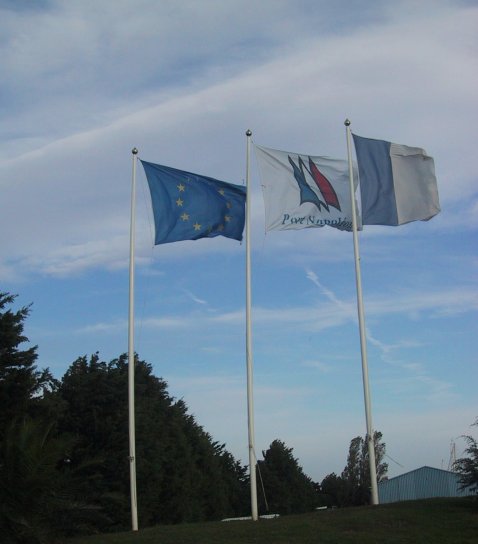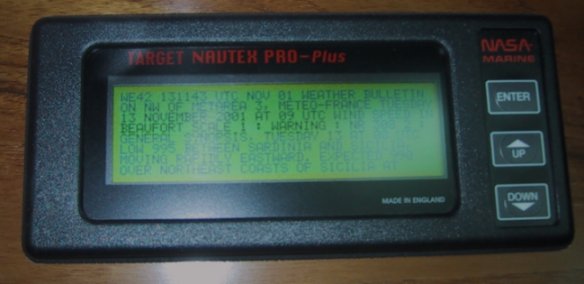David's Diary: Tuesday, November 13, 2001
The Mistral Blows in France

Port Napoleon In A Mistral
A common wind in the Gulf du Lion, where we are located, is the Mistral (Mistrau means master in Provenšal, thus we get master-wind). This wind occurs when there is a low pressure system in the Western Mediterranean and high pressure over France. With the Alps to the East and the Pyrenees to the South, there is nowhere for the wind to escape but down the Rhone valley. Wind, like water, always wants to flow downhill. In the case of wind, this is from areas of high pressure to low pressure. The greater the difference in pressure the higher the wind strength.
The Mistral wind blows from the Northwest and since we have returned to Port St. Louis from Cassis it has blown continuously twenty-four hours a day. Last night the wind strengthened as the depression in the Mediterranean continued to move.

Navtex
Getting accurate weather forecasts onboard Dragonsinger is a challenge. In Canada, there are continuous and detailed weather forecasts on dedicated weather channels on VHF radio. Such a service is not available in Europe and many people use a European weather service called Navtex. To use this service you must have a dedicated antenna and receiver. In our case we have a receiver with the capability of storing 800 lines of information. We leave it on all of the time so that any time that we want we can check the weather forecast. Weather forecasts by the French weather service are issued once or twice a day (compared to the three times a day that we are used to in Canada) and are available in English.
This morning the French weather service reported the following forecast on Navtex (we have only included the forecast for Western Provence where we are located, but forecasts for the entire Western Mediterranean were provided):
"WE42 131143 UTC NOV 01 WEATHER BULLETIN ON NW OF METAREA 3, METEO-FRANCE TUESDAY 13 NOVEMBER 2001 AT 09 UTC WIND SPEED IN BEAUFORT SCALE 1 : WARNING : NR 308 2 : GENERAL SYNOPSIS, TUESDAY 13 AT 00 UTC LOW 995 BETWEEN SARDINIA AND SICILIA, MOVING RAPIDLY EASTWARD, EXPECTED 990 OVER NORTHEAST COASTS OF SICILIA AT 13/12 UTC, HIGH BUILDING OVER SPAIN AND SOUTHWEST OF FRANCE TONIGHT, 3 : FORCASTS TO WEDNESDAY 14 AT 12 UTC ... WEST OF PROVENCE : N OR NW 8, AT TIMES 9 DURING DAY-TIME. GUSTS. MODERATE TO VERY ROUGH FROM NORTH TO SOUTH. LITTLE RAIN CLEARING. 4 : OUTLOOK FOR NEXT 24 HOURS PERSISTANCE OF NORTHEASTERLY STRONG FLOW FROM GULF OF GENOVA TO SOUTHEAST OF SPAIN. LOCALLY VIOLENT NEAR BALEARIC ISLANDS.
The meaning of the opening line needs some interpretation. "WE42" means WEather bulletin 42. The "131143 UTC NOV 01" means November 13, 2001 at 11:43 UTC. UTC is Greenwich Mean Time (GMT) and right now we are one hour ahead of GMT. Wind strength is measured in the Beaufort scale, a standardized form of nautical wind measurement. We are still adjusting to the Beaufort scale, as it is not used in Canada, but for reference here are the Beaufort ratings and the equivalent wind speed in knots and km/hr:
| Beaufort | Knots | km/hr |
| 0 | <1 | <1 |
| 1 | 1-3 | 1-5 |
| 2 | 4-6 | 6-11 |
| 3 | 7-10 | 12-19 |
| 4 | 11-16 | 20-28 |
| 5 | 17-21 | 29-38 |
| 6 | 22-27 | 39-49 |
| 7 | 28-33 | 50-61 |
| 8 | 34-40 | 62-74 |
| 9 | 41-47 | 75-88 |
| 10 | 48-55 | 89-102 |
| 11 | 56-63 | 103-117 |
| 12 | >63 | >118 |
The forecast is for Force 8 with gusts to Force 9, so we are at the high end of the Beaufort scale. It is no wonder that we can feel every gust as it hits Dragonsinger.

Actual Wind Measurement
We supplement the weather forecast with our on onboard measurements. Our wind instruments have been on since first thing this morning and the maximum wind speed reported is 49.8 knots (approximately 90 km/hr). Our barometer reads 1005.4, so the pressure difference where we are and the center of the low at 990 is large.
Life on board in these conditions can be challenging. While the wind is most often blowing at 25 or 30 knots, the gusts cause the boat to heel over three or four degrees. We are tied to the dock with multiple lines, but the strength of the wind bounces us off the dock despite our best efforts to prevent it.
Where we sail in Canada, it is not that common to have winds over twenty knots in the summer when we have done most of our cruising. At that wind speed we used to comment on the sound of the wind in the rigging. We now joke that twenty knots of wind feels quiet. It is the thirty and forty knot gusts that get our attention, whether it is on board feeling the boat heel or walking through Port Napoleon bent over as we push our way into the wind.